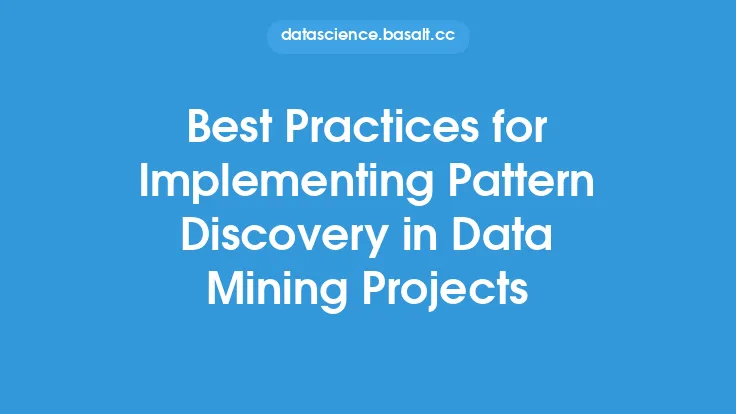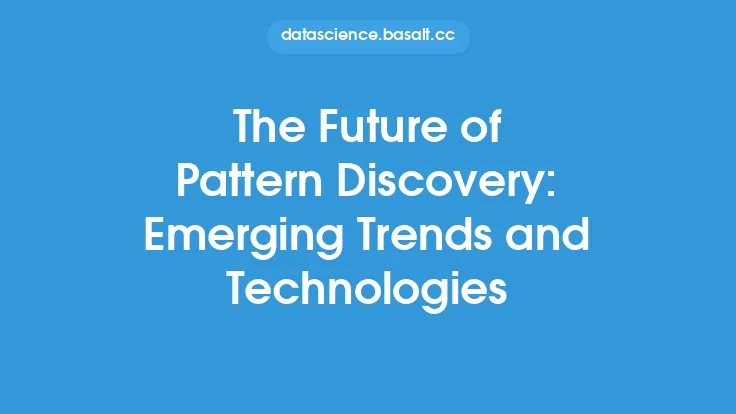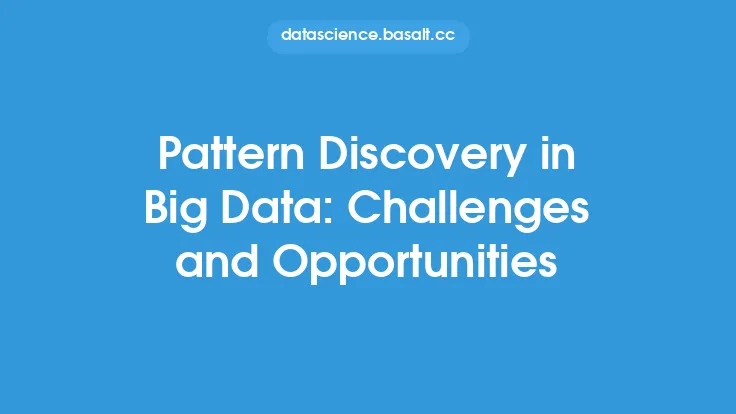Pattern discovery is a crucial aspect of data mining, which involves identifying meaningful and useful patterns, relationships, or trends within large datasets. This process enables organizations to extract valuable insights from their data, make informed decisions, and gain a competitive edge in the market. At its core, pattern discovery is about uncovering hidden patterns, relationships, or correlations that can inform business strategies, improve operations, and drive growth.
Introduction to Pattern Discovery Techniques
Pattern discovery techniques are a set of methods and algorithms used to identify patterns in data. These techniques can be broadly categorized into two main types: supervised and unsupervised learning. Supervised learning involves using labeled data to train a model, which can then be used to make predictions on new, unseen data. Unsupervised learning, on the other hand, involves using unlabeled data to identify patterns, relationships, or groupings. Some common pattern discovery techniques include decision trees, clustering, association rule mining, and neural networks. Each of these techniques has its strengths and weaknesses, and the choice of technique depends on the specific problem being addressed and the characteristics of the data.
Types of Pattern Discovery Techniques
There are several types of pattern discovery techniques, each with its own unique characteristics and applications. Decision trees, for example, are a type of supervised learning technique that involves creating a tree-like model of decisions and their possible consequences. Clustering, on the other hand, is an unsupervised learning technique that involves grouping similar data points into clusters. Association rule mining is another type of unsupervised learning technique that involves identifying relationships between different variables in a dataset. Neural networks are a type of supervised learning technique that involves training a network of interconnected nodes to make predictions on new data. Other pattern discovery techniques include regression analysis, discriminant analysis, and logistic regression.
Pattern Discovery Process
The pattern discovery process typically involves several steps, including data preparation, pattern discovery, and pattern evaluation. Data preparation involves cleaning, transforming, and formatting the data to prepare it for analysis. This step is critical, as the quality of the data can significantly impact the accuracy and reliability of the patterns discovered. Pattern discovery involves applying one or more pattern discovery techniques to the prepared data to identify meaningful patterns, relationships, or trends. Pattern evaluation involves assessing the quality and usefulness of the discovered patterns, and refining the pattern discovery process as needed.
Data Preparation for Pattern Discovery
Data preparation is a critical step in the pattern discovery process. This step involves cleaning, transforming, and formatting the data to prepare it for analysis. Data cleaning involves identifying and correcting errors, inconsistencies, and missing values in the data. Data transformation involves converting the data into a format that is suitable for analysis, such as aggregating data or converting categorical variables into numerical variables. Data formatting involves organizing the data into a structure that is suitable for analysis, such as creating a data matrix or a data cube. Other data preparation tasks include handling missing values, removing outliers, and normalizing the data.
Pattern Discovery Algorithms
Pattern discovery algorithms are the backbone of pattern discovery techniques. These algorithms involve using statistical and mathematical techniques to identify patterns, relationships, or trends in the data. Some common pattern discovery algorithms include the Apriori algorithm, the Eclat algorithm, and the FP-growth algorithm. The Apriori algorithm, for example, is a popular algorithm for association rule mining, which involves identifying relationships between different variables in a dataset. The Eclat algorithm is another popular algorithm for association rule mining, which involves using a vertical database layout to efficiently mine association rules. The FP-growth algorithm is a fast and efficient algorithm for mining frequent patterns in large datasets.
Challenges and Limitations of Pattern Discovery
Despite the many benefits of pattern discovery, there are several challenges and limitations to this technique. One of the main challenges is the quality of the data, which can significantly impact the accuracy and reliability of the patterns discovered. Another challenge is the complexity of the data, which can make it difficult to identify meaningful patterns, relationships, or trends. Other challenges include the presence of noise and outliers in the data, which can distort the patterns discovered, and the risk of overfitting or underfitting the data, which can result in poor predictive performance. Additionally, pattern discovery can be a time-consuming and computationally intensive process, which can require significant resources and expertise.
Real-World Applications of Pattern Discovery Techniques
Pattern discovery techniques have a wide range of real-world applications, including marketing, finance, healthcare, and customer relationship management. In marketing, pattern discovery can be used to identify customer segments, predict customer behavior, and optimize marketing campaigns. In finance, pattern discovery can be used to detect fraudulent transactions, predict stock prices, and optimize investment portfolios. In healthcare, pattern discovery can be used to identify disease patterns, predict patient outcomes, and optimize treatment strategies. In customer relationship management, pattern discovery can be used to identify customer preferences, predict customer churn, and optimize customer service strategies.
Evaluating Pattern Discovery Models
Evaluating pattern discovery models is a critical step in the pattern discovery process. This step involves assessing the quality and usefulness of the discovered patterns, and refining the pattern discovery process as needed. Some common metrics for evaluating pattern discovery models include accuracy, precision, recall, and F1 score. Accuracy measures the proportion of correct predictions made by the model, while precision measures the proportion of true positives among all positive predictions made by the model. Recall measures the proportion of true positives among all actual positive instances, while F1 score measures the harmonic mean of precision and recall. Other evaluation metrics include mean squared error, mean absolute error, and R-squared.
Best Practices for Implementing Pattern Discovery
Implementing pattern discovery techniques requires careful planning, execution, and evaluation. Some best practices for implementing pattern discovery include starting with a clear problem definition, selecting the right pattern discovery technique, preparing high-quality data, and evaluating the discovered patterns using appropriate metrics. Additionally, it is essential to consider the computational resources and expertise required for pattern discovery, as well as the potential risks and limitations of this technique. Other best practices include using visualization techniques to communicate the discovered patterns, using domain knowledge to refine the pattern discovery process, and using iterative refinement to improve the accuracy and reliability of the discovered patterns.
Future Directions for Pattern Discovery
The field of pattern discovery is constantly evolving, with new techniques, algorithms, and applications emerging all the time. Some future directions for pattern discovery include the use of deep learning techniques, such as convolutional neural networks and recurrent neural networks, to identify complex patterns in large datasets. Another future direction is the use of transfer learning and meta-learning to adapt pattern discovery models to new domains and tasks. Additionally, there is a growing interest in using pattern discovery techniques for social good, such as detecting fake news, predicting natural disasters, and optimizing healthcare outcomes. Other future directions include the use of pattern discovery techniques for real-time analytics, streaming data, and edge computing.





